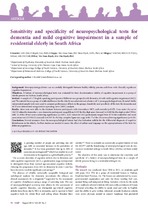| dc.contributor.author | Chipps, Jennifer | |
| dc.contributor.author | Ramlall, Suvira | |
| dc.contributor.author | Pillay, Basil | |
| dc.contributor.author | Bhigjee, Ahmed | |
| dc.date.accessioned | 2015-10-29T18:40:22Z | |
| dc.date.available | 2015-10-29T18:40:22Z | |
| dc.date.issued | 2014 | |
| dc.identifier.citation | Ramlall, S., et al., (2014). Sensitivity and specificity of neuropsychological tests for dementia and mild cognitive impairment in a sample of residential elderly in South Africa. South Africa Journal of Psychiatry, vol20(4):153-159 | en_US |
| dc.identifier.issn | 1608-9685 | |
| dc.identifier.uri | http://hdl.handle.net/10566/1943 | |
| dc.description.abstract | BACKGROUND. Neuropsychological tests can successfully distinguish between healthy elderly persons and those with clinically significant cognitive impairment.
Objectives. A battery of neuropsychological tests was evaluated for their discrimination validity of cognitive impairment in a group of elderly persons in Durban, South Africa.
METHOD. A sample of 117 English-speaking participants of different race groups (9 with dementia, 30 with mild cognitive impairment (MCI) and 78 controls) from a group of residential homes for the elderly was administered a battery of 11 neuropsychological tests. Kruskal-Wallis independent sample tests were used to compare performance of tests in the groups. Sensitivity and specificity of the tests for dementia and MCI were determined using random operating curve (ROC) analysis.
RESULTS. Most tests were able to discriminate between participants with dementia or MCI, and controls (p<0.05). Area under the curve (AUC) values for dementia v. non-dementia participants ranged from 0.519 for the digit span (forward) to 0.828 for the digit symbol (90 s), with 14 of the 29 test scores achieving significance (p<0.05). AUC values for MCI participants ranged from 0.754 for controlled oral word association test (COWAT) (Animal) to 0.507 for the Rey complex figure test copy, with 17 of the 29 scores achieving significance (p<0.05).
CONCLUSION. Several measures from the neuropsychological battery had discrimination validity for the differential diagnosis of cognitive disturbances in the elderly. Further studies are needed to assess the effect of culture and language on the appropriateness of the tests for different populations. | en_US |
| dc.language.iso | en | en_US |
| dc.publisher | Health & Medical Publishing Group | en_US |
| dc.relation.ispartofseries | South African Journal of Psychiatry; | |
| dc.rights | All articles published by the SAJP are made freely and permanently accessible online immediately upon publication, without subscription charges or registration barriers. The journal provides immediate open access to its content on the principle that making research freely available to the public supports a greater global exchange of knowledge.
Work published in the journal is licensed under a Creative Commons Attribution - Noncommercial 3.0 Unported Works License (CC BY-NC 3.0). | |
| dc.source.uri | http://dx.doi.org/10.7196/SAJP.558 | |
| dc.subject | Dementia | en_US |
| dc.subject | Screening | en_US |
| dc.subject | Neuropsychology | en_US |
| dc.subject | Elderly | en_US |
| dc.subject | Mild cognitive impairment (MCI) | en_US |
| dc.title | Sensitivity and specificity of neuropsychological tests for dementia and mild cognitive impairment in a sample of residential elderly in South Africa | en_US |
| dc.type | Article | en_US |
| dc.privacy.showsubmitter | false | |
| dc.status.ispeerreviewed | true | |
| dc.description.accreditation | Web of Science | en_US |

